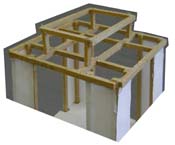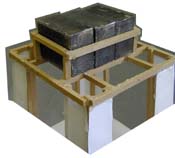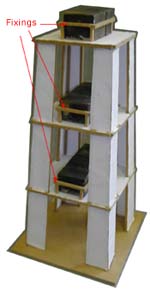


Before the paper floor is added.

We are only using one size of steel block to minimise the total number of steel blocks we need to buy. |
| If we used lots of different sized blocks we would need quite a lot of them to make sure we could load each model accurately. |
That would be very expensive. |
When you make a scale model of a building, its SIZE
is reduced. |
| The model is lighter than it should be. |
Your model must carry extra weights to correct for this problem. |
Rules for Vertical LoadYour model should be strong enough to carry a vertical load (Why ?) and must follow these rules.
You need Real Player installed on your computer to play these videos. Visit the IDEERS help pages to find out how to get a free copy. Get advice on how best to view the video clips here. |
|

